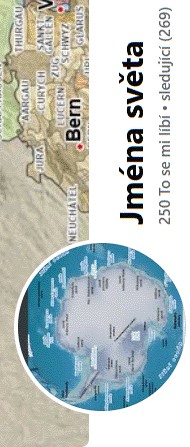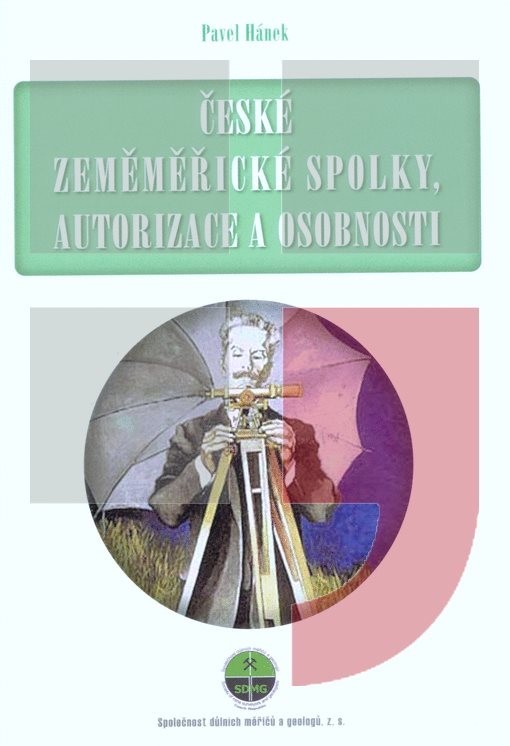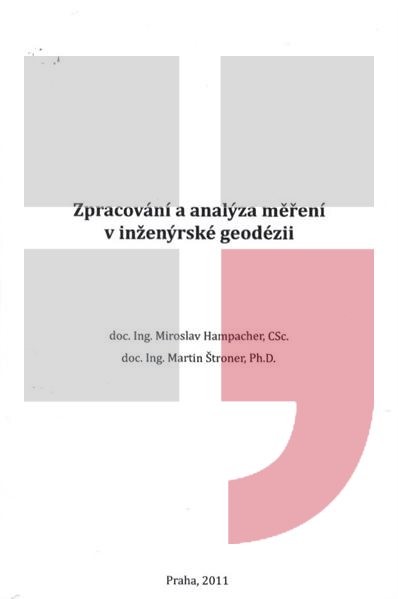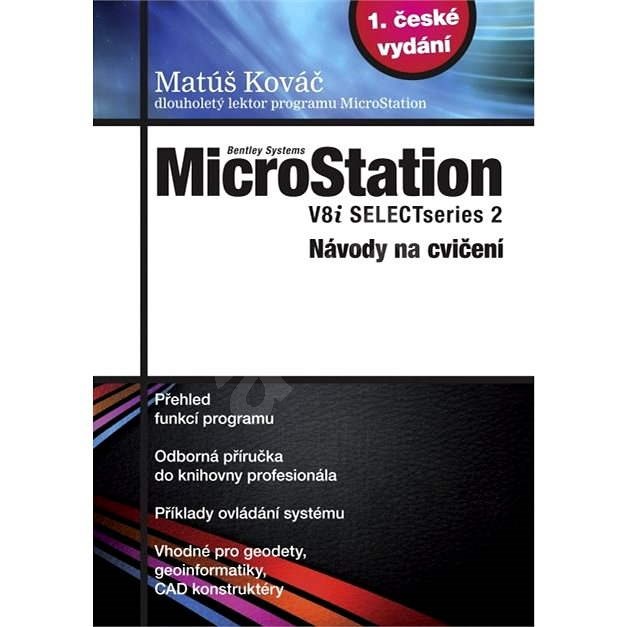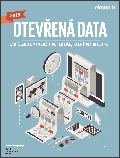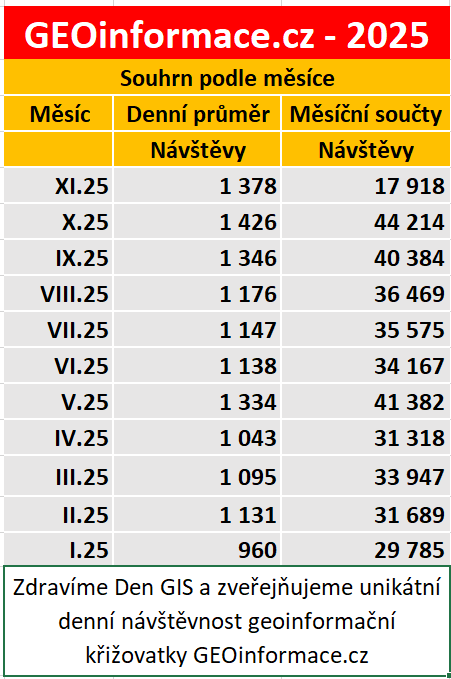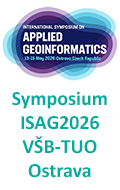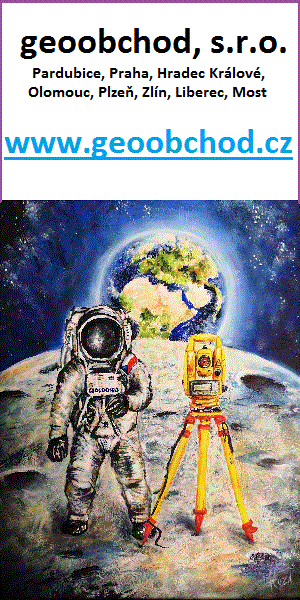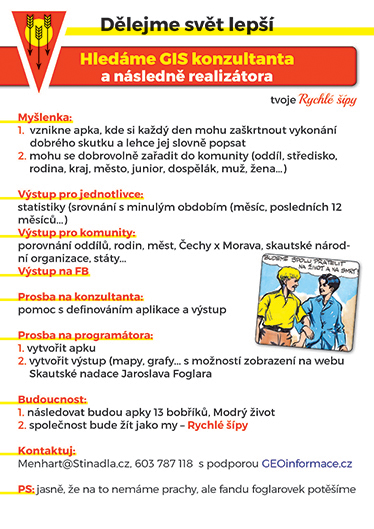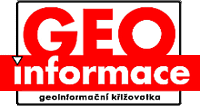zprávy
zdroje zpráv:CEDA e-slaví 20 let
2.3.2021 9:35 CEDA Maps a.s. Praha, 2. března 2021 - Právě v této době oslavujeme 20 let, co společnost CEDA Maps a.s., tehdy ještě jako Central European data Agency, a.s. začala podnikat. Za normální situace bychom pozvali naše partnery, kolegy a další příznivce a oslavili bychom toto kulaté výročí společně. Bohužel to nyní není možné, a tak mi dovolte alespoň dálku symbolicky připít CEDA na zdraví a poděkovat všem, kteří se přičinili o to, že CEDA vyrostla a dospěla v silnou, úspěšnou společnost.Vrchní referent/rada v personálním oddělení v Kanceláři ředitele katastrálního úřadu
2.3.2021 9:22 ČÚZK /Urady/Katastralni-urady/Katastralni-urady/Katastralni-urad-pro-Jihomoravsky-kraj/Volna-mista/DMS/Vrchni-referent-rada-v-personalnim-oddeleni-v-(1)Vrchní referent/rada v personálním oddělení v Kanceláři ředitele katastrálního úřadu
2.3.2021 9:22 ČÚZK - volná místa Katastrální úřad pro Jihomoravský kraj kancelář úřadu vypisuje výběrové řízení na místo Vrchní referent/rada v personálním oddělení v Kanceláři ředitele katastrálního úřaduVrchní referent/rada v personálním oddělení v Kanceláři ředitele katastrálního úřadu
2.3.2021 9:22 ČÚZK - předpisy a opatření Katastrální úřad pro Jihomoravský kraj kancelář úřaduvypisuje výběrové řízení na místo
Vrchní referent/rada v personálním oddělení v Kanceláři ředitele katastrálního úřadu
Nefunkčnost Geoportálu ÚAP
2.3.2021 8:30 Ústecký kraj Z technických důvodů nejsou v současné době prováděny aktualizace dat. Objednávkový systém dat ÚAP funguje, nicméně objednávky jsou vyřizovány mimo systém, manuálně.odborný referent v oddělení dokumentace katastru nemovitostí
2.3.2021 6:45 ČÚZK /Urady/Katastralni-urady/Katastralni-urady/Katastralni-urad-pro-Liberecky-kraj/Uredni-deska/Oznameni-a-jina-uredni-sdeleni/Volna-mista/odborny-referent-v-oddeleni-dokumentace-katast-(1)odborný referent v oddělení dokumentace katastru nemovitostí
2.3.2021 6:45 ČÚZK - volná místa Katastrální úřad pro Liberecký kraj - Katastrální pracoviště Liberec vypisuje výběrové řízení na místo odborný referent v oddělení dokumentace katastru nemovitostíodborný referent v oddělení dokumentace katastru nemovitostí
2.3.2021 6:45 ČÚZK - předpisy a opatření Katastrální úřad pro Liberecký kraj - Katastrální pracoviště Liberecvypisuje výběrové řízení na místo
odborný referent v oddělení dokumentace katastru nemovitostí
Online data z dopravy a jejich využití
2.3.2021 6:23 GeoBusinessVěděli jste, že díky analýze dat v reálném čase je možné sledovat aktuální dění v dopravě, obsazenost parkovacích míst nebo dobíjecích stanic pro elektromobily? Podívejte se na prezentaci firmy CEDA Maps o efektivním využití online dat v dopravě. Přednáška byla součástí videokonference GIS Esri v ČR na podzim 2020. Za firmu CEDA Maps přednášeli Radovan […]
The post Online data z dopravy a jejich využití appeared first on GeoBusiness.
GIVS 2021. Přihlaste se na konferenci Geoinformace ve veřejné správě
1.3.2021 19:28 GeoBusinessČeská asociace pro geoinformace pořádá počátkem května konferenci Geoinformace ve veřejné správě. Letos, podobně jako v předchozím roce, bude konference z důvodu přetrvávající situace s covid-19 v online podobě jako videokonference. 14. ročník konference Geoinformace ve veřejné správě 2021 se uskuteční v termínu 3. až 4. května. Témata konference GIVS 2021 DMVS, DTM, Digitalizace stavebního […]
The post GIVS 2021. Přihlaste se na konferenci Geoinformace ve veřejné správě appeared first on GeoBusiness.
CoreLogic Confirms Receipt of Revised Acquisition Proposal from CoStar
1.3.2021 19:11 GISCafe.com Webcasts-Webinars IRVINE, Calif. — (BUSINESS WIRE) — March 1, 2021 —CoreLogic® (NYSE: CLGX), a leading global property data and analytics-driven …
dataPlor launches LATAM regional SMB dataset with over five million verified records
1.3.2021 19:11 GISCafe.com Webcasts-Webinars dataPlor, a leading provider of emerging markets business and point-of-interest (POI) data today announced the launch of its licensable Latin …ST Engineering Geo-Insights Partners with BlackSky to Offer Expanded Satellite Imaging and Analytics Insights Portfolio for Customers in Southeast Asia
1.3.2021 16:53 GISCafe.com Webcasts-Webinars SINGAPORE & HERNDON, Va. — (BUSINESS WIRE) — February 28, 2021 —ST Engineering’s earth observation and geospatial analysis …
CoreLogic Reports Record Full-Year and Fourth Quarter 2020 Revenue, Operating Income, Profit Margins and Cash Flow
1.3.2021 16:53 GISCafe.com Webcasts-Webinars Fueled by Double-Digit Revenue Growth Driven by Housing Market Activity and Share Gains, Operating Leverage and Cost ProductivityReturned $595 …
U.S. Autonomous Drone Maker Skydio Announces $170 Million In Series D Funding Led by Andreessen Horowitz’s Growth Fund
1.3.2021 16:53 GISCafe.com Webcasts-Webinars REDWOOD CITY, Calif. — (BUSINESS WIRE) — March 1, 2021 —Skydio, the leading U.S. drone manufacturer and world leader in …
Workhorse Group Reports Fourth Quarter and Full Year 2020 Results
1.3.2021 16:53 GISCafe.com Webcasts-Webinars CINCINNATI, March 01, 2021 (GLOBE NEWSWIRE) -- Workhorse Group Inc. (Nasdaq: WKHS) (“Workhorse” or “the Company”), an American technology …Změna úředních hodin
1.3.2021 15:25 ČÚZK - předpisy a opatření Katastrální úřad pro Středočeský kraj - Katastrální pracoviště Slaný zveřejnil novou aktualitu: Změna úředních hodin Od 3.3.2021 bude na KP Slaný změna úředních hodin pro veřejnost:Pondělí 8 - 17 hod.
Středa 8 - 17 hod.
Ostatní dny bude pracoviště pro veřejnost uzavřené, v tyto dny je možné podání hodit do sběrného boxu vedle vchodových dveří.
Změna úředních hodin od 1.3.2021
1.3.2021 14:32 ČÚZK /Urady/Katastralni-urady/Katastralni-urady/Katastralni-urad-pro-Stredocesky-kraj/Katastralni-pracoviste/KP-Rakovnik/O-uradu/Aktuality/Zmena-urednich-hodin-od-1-3-2021Změna úředních hodin od 1.3.2021
1.3.2021 14:32 ČÚZK - předpisy a opatření Katastrální úřad pro Středočeský kraj - Katastrální pracoviště Rakovník zveřejnil novou aktualitu: Od 1.3.2021 dochází ke změně úředních hodin a to:PONDĚLÍ 8-17 hodin a
STŘEDA 8-17 hodin
20210301_Informace
1.3.2021 13:58 ČÚZK - předpisy a opatření Zeměměřický úřad zveřejnil novou aktualitu: V souladu s Usnesením vlády ČR č. 199 ze dne 26. února je uzavřena pro návštěvy veřejnosti badatelna Ústředního archivu zeměměřictví a katastru a prodejna map. Je nutné upřednostnit jiné způsoby komunikace, např. e-mail, datová zpráva, popř. telefon. V případě objednání tištěných produktů využijte možnosti zaslání poštou, nevolte prosím osobní odběr v prodejně map. Služby Geoportálu ČÚZK včetně CZEPOS a dalších geodetických aplikací pro potřeby zeměměřičů jsou provozovány bez omezení.20210301_Informace
1.3.2021 13:58 Zeměměřický úřad Zeměměřický úřad zveřejnil novou aktualitu: V souladu s Usnesením vlády ČR č. 199 ze dne 26. února je uzavřena pro návštěvy veřejnosti badatelna Ústředního archivu zeměměřictví a katastru a prodejna map. Je nutné upřednostnit jiné způsoby komunikace, např. e-mail, datová zpráva, popř. telefon. V případě objednání tištěných produktů využijte možnosti zaslání poštou, nevolte prosím osobní odběr v prodejně map. Služby Geoportálu ČÚZK včetně CZEPOS a dalších geodetických aplikací pro potřeby zeměměřičů jsou provozovány bez omezení.20210301_Informace
1.3.2021 13:58 Zeměměřický úřad Zeměměřický úřadzveřejnil novou aktualitu: V souladu s Usnesením vlády ČR č. 199 ze dne 26. února je uzavřena pro návštěvy veřejnosti badatelna Ústředního archivu zeměměřictví a katastru a prodejna map. Je nutné upřednostnit jiné způsoby komunikace, např. e-mail, datová zpráva, popř. telefon. V případě objednání tištěných produktů využijte možnosti zaslání poštou, nevolte prosím osobní odběr v prodejně map. Služby Geoportálu ČÚZK včetně CZEPOS a dalších geodetických aplikací pro potřeby zeměměřičů jsou provozovány bez omezení.
20210301_Informace
1.3.2021 13:58 ČÚZK - předpisy a opatření Zeměměřický úřadzveřejnil novou aktualitu: V souladu s Usnesením vlády ČR č. 199 ze dne 26. února je uzavřena pro návštěvy veřejnosti badatelna Ústředního archivu zeměměřictví a katastru a prodejna map. Je nutné upřednostnit jiné způsoby komunikace, např. e-mail, datová zpráva, popř. telefon. V případě objednání tištěných produktů využijte možnosti zaslání poštou, nevolte prosím osobní odběr v prodejně map. Služby Geoportálu ČÚZK včetně CZEPOS a dalších geodetických aplikací pro potřeby zeměměřičů jsou provozovány bez omezení.
ODSTÁVKA MAPOVÝCH SLUŽEB
1.3.2021 13:00 Plzeňský kraj Během měsíce února byly postupně obnoveny nejvyužívanější mapové aplikace. Na úpravě dalších se i na základě požadavků uživatelů pracuje. Za vzniklé potíže se omlouváme.ODSTÁVKA MAPOVÝCH SLUŽEB
1.3.2021 13:00 Plzeňský kraj Během měsíce února byly postupně obnoveny nejvyužívanější mapové aplikace. Na úpravě dalších se pracuje. Za vzniklé potíže se omlouváme.Oznámení o omezeném provozu katastrálních pracovišť
1.3.2021 12:56 ČÚZK - předpisy a opatření Katastrální úřad pro Jihočeský kraj zveřejnil novou aktualitu: Oznámení o omezeném provozu katastrálních pracovišť Katastrálního úřadu pro Jihočeský kraj v období od 1. března 2021 po dobu nouzového stavu.Nedostupnost WSDP na zkoušku dne 2.3.2021 od 10 do 11 hodin
1.3.2021 11:11 Dálkový přístup k údajům KN ČR Vážení uživatelé webových služeb,oznamujeme, že z technických důvodů budou dne 2.3.2021 v době od 10 do 11 hodin nedostupné webové služby dálkového přístupu na zkoušku.
Za komplikace se omlouváme a děkujeme za pochopení.
Nedostupnost WSDP na zkoušku dne 2.3.2021 od 10 do 11 hodin
1.3.2021 11:11 ČÚZK - předpisy a opatření Vážení uživatelé webových služeb,oznamujeme, že z technických důvodů budou dne 2.3.2021 v době od 10 do 11 hodin nedostupné webové služby dálkového přístupu na zkoušku.
Za komplikace se omlouváme a děkujeme za pochopení.
Nedostupnost WSDP na zkoušku dne 2.3.2021 od 10 do 11 hodin
1.3.2021 11:11 ČÚZK /Aplikace-DP-do-KN/Aplikace-DP-do-KN/Archiv-DP/31517530. Mezinárodní kartografická konference
1.3.2021 10:52 Česká kartografická společnost V termínu od 14. do 18. prosince 2021 se v italské Florencii uskuteční v pořadí již 30. Mezinárodní kartografická konference, v rámci níž se koná i Mezinárodní kartografická výstava a výstava dětských kreseb v rámci soutěže Dětská mapa světa Barbary Petchenik. Pro aktivní účastníky konference jsou důležité termíny 19. 3. (uzávěrka pro full-papers), 28. 5. […]20210301 - Upozornění uživatelům VFR
1.3.2021 10:47 ČÚZK /Uvod/Produkty-a-sluzby/RUIAN/2-Poskytovani-udaju-RUIAN-ISUI-VDP/Vymenny-format-RUIAN/Archiv-novinek-VFR/20210301-Upozorneni-uzivatelum-VFR20210301 - Upozornění uživatelům VFR
1.3.2021 10:47 ČÚZK - předpisy a opatření Upozornění uživatelům VFR: Identifikovali jsme problém s generováním současných stavových (měsíčních) souborů VFR za únor 2021. Soubory nejsou momentálně k dispozici, na nápravě intenzivně pracujeme. Omlouváme se uživatelům dat RÚIAN za komplikace.Zveřejněno: 1. 3. 2021
20210301 - Upozornění uživatelům VFR
1.3.2021 10:40 ČÚZK - předpisy a opatření Upozornění uživatelům VFR: Současné stavové (měsíční) soubory VFR za únor 2021 byly vygenerovány o dva dny později, mají tedy označení 20210302_*, ale obsahově jsou se stavem dat k 28. 2. 2021. Soubory jsou dostupné i pod názvem 20210228_*.20210301 - Upozornění uživatelům VFR
1.3.2021 10:40 ČÚZK - předpisy a opatření Upozornění uživatelům VFR: Současné stavové (měsíční) soubory VFR za únor 2021 byly vygenerovány o dva dny později, mají tedy označení 20210302_*, ale obsahově jsou se stavem dat k 28. 2. 2021.20210301 - Upozornění uživatelům VFR
1.3.2021 10:40 ČÚZK /Uvod/Produkty-a-sluzby/RUIAN/RUIAN-novinky/2021/20210301-Upozorneni-uzivatelum-VFR20210301 - Upozornění uživatelům VFR
1.3.2021 10:40 ČÚZK - předpisy a opatření Upozornění uživatelům VFR: Identifikovali jsme problém s generováním současných stavových (měsíčních) souborů VFR za únor 2021. Soubory nejsou momentálně k dispozici, na nápravě intenzivně pracujeme. Omlouváme se uživatelům dat RÚIAN za komplikace.23. ročník soutěže Mapa roku
1.3.2021 10:31 Česká kartografická společnost Česká kartografická společnost v letošním roce pořádá již 23. ročník odborné kartografické soutěže Mapa roku. Vítáme všechny autory a producenty kartografických děl, a to těch tradičních i netradičních. O titul Mapa roku 2020 se bojuje v pěti kategoriích, nad rámec kategorií jsou pak udělována Zvláštní ocenění. Nejzajímavější díla po vyhodnocení národního kola poputují na Mezinárodní […]Výtvarná soutěž pro děti: Mapa mého budoucího světa
1.3.2021 10:30 Česká kartografická společnost Národní kolo umělecko-kartografické soutěže Dětská mapa světa Barbary Petchenik pořádá Česká kartografická společnost ve spolupráci s Katedrou geografie Technické univerzity v Liberci. Téma pro letošní ročník je Mapa mého budoucího světa (A Map of My Future World). Podrobná pravidla, věkové kategorie a hodnocená kritéria jsou popsána na stránkách soutěže. Uzávěrka pro zasílání obrázků je 15. 6. 2021. Vybraná […]Webová aplikace hranic obcí a okresů
1.3.2021 9:55 V reakci na aktuální situaci a omezení pohybu, pro vás katedra geoinformatiky připravila webovou aplikaci pro prohlížení hranic obcí a okresů na odkaze: https://geoinformatika-1.vsb.cz/hranice-obce/Aktualizace Data50
1.3.2021 9:19 ČÚZK - Geoportál Aktualizace Data50Byla provedena pravidelná roční aktualizace datové sady Data50 (digitální geografický model území České republiky odvozený z kartografické databáze pro Základní mapu ČR 1 : 50 000), která je poskytována bezplatně jako otevřená data.
Nová aktualizace již také zahrnuje změny RÚIAN, které od 1. 1. 2021 nastaly v souvislosti
s účinností zákona č. 51/2020 Sb., o územně správním členění státu.
Aktualizována byla i příslušná prohlížecí služba ArcGIS Server, která poskytuje i WMS rozhraní.
Aktualizace Data50
1.3.2021 9:19 ČÚZK - Geoportál Aktualizace Data50Byla provedena pravidelná roční aktualizace datové sady Data50 (digitální geografický model území České republiky odvozený z kartografické databáze pro Základní mapu ČR 1 : 50 000), která je poskytována bezplatně jako otevřená data.
Nová aktualizace již také zahrnuje změny RÚIAN, které od 1. 1. 2021 nastaly v souvislosti
s účinností zákona č. 51/2020 Sb., o územně správním členění státu.
Aktualizována byla i příslušná prohlížecí služba ArcGIS Server, která poskytuje i WMS rozhraní.
Aktualizace Data50
1.3.2021 9:19 ČÚZK - Geoportál Aktualizace Data50Byla provedena pravidelná roční aktualizace datové sady Data50 (digitální geografický model území České republiky odvozený z kartografické databáze pro Základní mapu ČR 1 : 50 000), která je poskytována bezplatně jako otevřená data.
Nová aktualizace již také zahrnuje změny RÚIAN, které od 1. 1. 2021 nastaly v souvislosti
s účinností zákona č. 51/2020 Sb., o územně správním členění státu.
Aktualizována byla i příslušná prohlížecí služba ArcGIS Server, která poskytuje i WMS rozhraní.
Aktualizace Data50
1.3.2021 9:19 ČÚZK - Geoportál Aktualizace Data50Byla provedena pravidelná roční aktualizace datové sady Data50 (digitální geografický model území České republiky odvozený z kartografické databáze pro Základní mapu ČR 1 : 50 000), která je poskytována bezplatně jako otevřená data.
Nová aktualizace již také zahrnuje změny RÚIAN, které od 1. 1. 2021 nastaly v souvislosti
s účinností zákona č. 51/2020 Sb., o územně správním členění státu.
Aktualizována byla i příslušná prohlížecí služba ArcGIS Server, která poskytuje i WMS rozhraní.
Aktualizace Data50
1.3.2021 9:19 ČÚZK - Geoportál Aktualizace Data50Byla provedena pravidelná roční aktualizace datové sady Data50 (digitální geografický model území České republiky odvozený z kartografické databáze pro Základní mapu ČR 1 : 50 000), která je poskytována bezplatně jako otevřená data.
Nová aktualizace již také zahrnuje změny RÚIAN, které od 1. 1. 2021 nastaly v souvislosti
s účinností zákona č. 51/2020 Sb., o územně správním členění státu.
Aktualizována byla i příslušná prohlížecí služba ArcGIS Server, která poskytuje i WMS rozhraní.
Aktualizace Data50
1.3.2021 9:19 ČÚZK - Geoportál Aktualizace Data50Byla provedena pravidelná roční aktualizace datové sady Data50 (digitální geografický model území České republiky odvozený z kartografické databáze pro Základní mapu ČR 1 : 50 000), která je poskytována bezplatně jako otevřená data.
Nová aktualizace již také zahrnuje změny RÚIAN, které od 1. 1. 2021 nastaly v souvislosti
s účinností zákona č. 51/2020 Sb., o územně správním členění státu.
Aktualizována byla i příslušná prohlížecí služba ArcGIS Server, která poskytuje i WMS rozhraní.
Aktualizace Data50
1.3.2021 9:19 ČÚZK - Geoportál Aktualizace Data50Byla provedena pravidelná roční aktualizace datové sady Data50 (digitální geografický model území České republiky odvozený z kartografické databáze pro Základní mapu ČR 1 : 50 000), která je poskytována bezplatně jako otevřená data.
Nová aktualizace již také zahrnuje změny RÚIAN, které od 1. 1. 2021 nastaly v souvislosti
s účinností zákona č. 51/2020 Sb., o územně správním členění státu.
Aktualizována byla i příslušná prohlížecí služba ArcGIS Server, která poskytuje i WMS rozhraní.
Aktualizace Data50
1.3.2021 9:19 ČÚZK - Geoportál Aktualizace Data50Byla provedena pravidelná roční aktualizace datové sady Data50 (digitální geografický model území České republiky odvozený z kartografické databáze pro Základní mapu ČR 1 : 50 000), která je poskytována bezplatně jako otevřená data.
Nová aktualizace již také zahrnuje změny RÚIAN, které od 1. 1. 2021 nastaly v souvislosti
s účinností zákona č. 51/2020 Sb., o územně správním členění státu.
Aktualizována byla i příslušná prohlížecí služba ArcGIS Server, která poskytuje i WMS rozhraní.
Aktualizace Data50
1.3.2021 9:19 ČÚZK - Geoportál Aktualizace Data50Byla provedena pravidelná roční aktualizace datové sady Data50 (digitální geografický model území České republiky odvozený z kartografické databáze pro Základní mapu ČR 1 : 50 000), která je poskytována bezplatně jako otevřená data.
Nová aktualizace již také zahrnuje změny RÚIAN, které od 1. 1. 2021 nastaly v souvislosti
s účinností zákona č. 51/2020 Sb., o územně správním členění státu.
Aktualizována byla i příslušná prohlížecí služba ArcGIS Server, která poskytuje i WMS rozhraní.
Aktualizace Data50
1.3.2021 9:19 ČÚZK - Geoportál Aktualizace Data50Byla provedena pravidelná roční aktualizace datové sady Data50 (digitální geografický model území České republiky odvozený z kartografické databáze pro Základní mapu ČR 1 : 50 000), která je poskytována bezplatně jako otevřená data.
Nová aktualizace již také zahrnuje změny RÚIAN, které od 1. 1. 2021 nastaly v souvislosti
s účinností zákona č. 51/2020 Sb., o územně správním členění státu.
Aktualizována byla i příslušná prohlížecí služba ArcGIS Server, která poskytuje i WMS rozhraní.
Česká kartografická společnost vyhlašuje 23. ročník kartografické soutěže Mapa roku
1.3.2021 8:41 GISportal.cz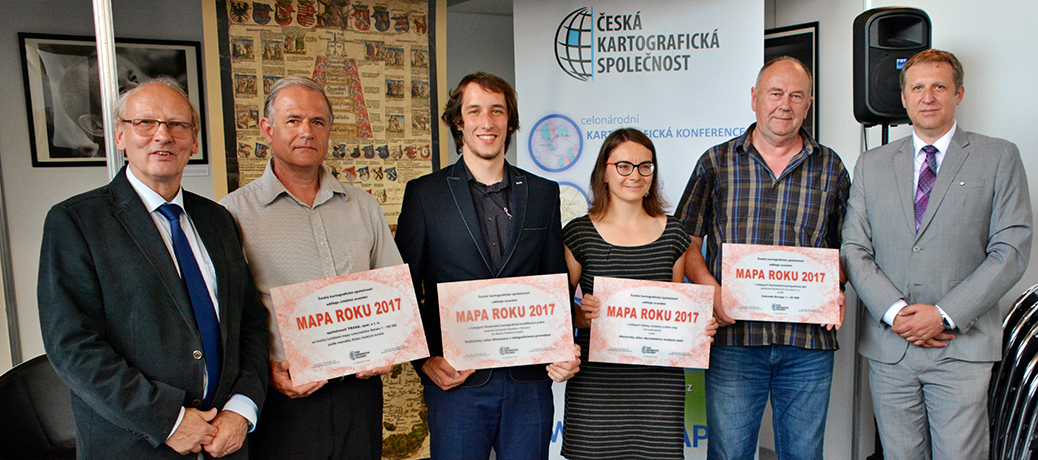
Zúčastněte se tradičního kartografického klání a získejte pro své dílo ocenění Mapa roku 2020! Vítáme všechny autory a producenty kartografických produktů, a to těch tradičních i netradičních. Stejně jako v loňském roce proběhne výstava všech nominovaných a dalších vybraných produktů, která bude přístupná široké veřejnosti. Nejzajímavější díla pak poputují na Mezinárodní kartografickou výstavu, která se […]
The post Česká kartografická společnost vyhlašuje 23. ročník kartografické soutěže Mapa roku appeared first on GISportal.cz.
Mapová aplikace ÚPD - nové dokumentace
1.3.2021 8:30 Jihočeský kraj V mapové aplikaci Územně plánovací dokumentace obcí byla aktualizována ÚPD obcí ORP Jindřichův Hradec – Stráž nad Nežárkou, Kardašova Řečice, ORP Český Krumlov – Český Krumlov, ORP Milevsko – Stehlovice, ORP Třeboň - TřeboňMapová aplikace ÚPD - nové dokumentace
1.3.2021 8:30 Jihočeský kraj V mapové aplikaci Územně plánovací dokumentace obcí byla aktualizována ÚPD obcí ORP Jindřichův Hradec – Stráž nad Nežárkou, Kardašova Řečice, ORP Český Krumlov – Český Krumlov, ORP Milevsko – Stehlovice, ORP Třeboň - Třeboň, ORP Soběslav - ŘípecProč jsou výstavby sítí důležité pro budoucnost
28.2.2021 12:45 Unicorn V časopise Next Generation Telekomunikace vyšel článek o významu optických sítí pro veřejnost a místní samosprávu. Provádí nás celým procesem výstavby sítí FTTH a také se zmiňuje o řešení pro rozvoj a plánování optické sítě, které Unicorn připravil ve spolupráci s holandským partnerem Geostruct.SharkCAD Pro MAC 12 CZ
26.2.2021 21:52 ŠPINAR - software Vážení zákazníci, dovolujeme si Vám představit nový CAD pro platformu Macintosh SharkCAD Pro MAC v12 CZ. V akční slevě do 4. 3. 2021! SharkCAD MAC CZ nabízí přehledné prostředí se silnými nástrojů pro 2D / 3D kreslení a vizualizace pro platformu Macintosh. Kompletní nabídku CAD programů pro platformu Macintosh nabízíme pod populární značkou TurboCAD. 2D/3D kreslící a editační...Read moreSharkCAD Pro MAC 12 CZ
26.2.2021 21:52 ŠPINAR - softwareVážení zákazníci, dovolujeme si Vám představit nový CAD pro platformu Macintosh SharkCAD Pro v12 CZ. V akční slevě do 4. 3. 2021! TurboCAD MAC CZ nabízí přehledné prostředí se silnými nástrojů pro 2D a 3D kreslení 2D/3D kreslící a editační nástroje Rozšířené nástroje pro architekturu Široká nabídka materiálů a symboly Obtisknutí textu na 3D povrch Fotorealistické zobrazení 3D...Read more
The post SharkCAD Pro MAC 12 CZ appeared first on ŠPINAR – software.
SharkCAD Pro MAC 12 CZ
26.2.2021 21:52 ŠPINAR - softwareVážení zákazníci, dovolujeme si Vám představit nový CAD pro platformu Macintosh SharkCAD Pro MAC v12 CZ. V akční slevě do 4. 3. 2021! SharkCAD MAC CZ nabízí přehledné prostředí se silnými nástrojů pro 2D / 3D kreslení a vizualizace pro platformu Macintosh. Kompletní nabídku CAD programů pro platformu Macintosh nabízíme pod populární značkou TurboCAD. 2D/3D kreslící a editační...Read more
The post SharkCAD Pro MAC 12 CZ appeared first on ŠPINAR – software.
SharkCAD Pro MAC 12 CZ
26.2.2021 21:52 ŠPINAR - softwareVážení zákazníci, dovolujeme si Vám představit nový CAD pro platformu Macintosh SharkCAD Pro MAC v12 CZ. V akční slevě do 4. 3. 2021! SharkCAD MAC CZ nabízí přehledné prostředí se silnými nástrojů pro 2D / 3D kreslení a vizualizace pro platformu Macintosh. Kompletní nabídku CAD programů pro platformu Macintosh nabízíme pod populární značkou TurboCAD. 2D/3D kreslící a editační...Read more
The post SharkCAD Pro MAC 12 CZ appeared first on ŠPINAR – software.
SharkCAD Pro MAC 12 CZ
26.2.2021 21:52 ŠPINAR - softwareVážení zákazníci, dovolujeme si Vám představit nový CAD pro platformu Macintosh SharkCAD Pro v12 CZ. V akční slevě do 4. 3. 2021! TurboCAD MAC CZ nabízí přehledné prostředí se silnými nástrojů pro 2D a 3D kreslení 2D/3D kreslící a editační nástroje Rozšířené nástroje pro architekturu Široká nabídka materiálů a symboly Obtisknutí textu na 3D povrch Fotorealistické zobrazení 3D...Read more
The post SharkCAD Pro MAC 12 CZ appeared first on ŠPINAR – software.
Efficiency is in Season: senseFly Launches eBee Ag Fixed-wing Mapping Drone for Agriculture
26.2.2021 20:17 GISCafe.com Webcasts-Webinars CHESEAUX-SUR-LAUSANNE, Switzerland, 15th February 2021 – senseFly, the global leader in fixed-wing mapping drones, today announces the launch …FOURSQUARE, KOREM CEMENT PARTNERSHIP TO ENHANCE FOCUS ON GEOSPATIAL DATA
26.2.2021 20:11 GISCafe.com Webcasts-Webinars NEW YORK, NY and QUÉBEC CITY, QC, February 16, 2021 – Foursquare, the leading independent location technology company and Korem, the …Vytvořili jste mapu? Soutěž Mapa roku se koná i letos
26.2.2021 18:22 GeoBusinessČeská kartografická společnost již přes dvacet let pořádá soutěž Mapa roku. Do letošního ročníku soutěže můžete své kartografické dílo přihlašovat do 20. března. Podobně jako v roce 2020 i tentokrát se uskuteční výstava všech nominovaných a dalších vybraných produktů. Nejzajímavější díla vezme Česká kartografická společnost v prosinci 2021 s sebou do Itálie na mezinárodní kartografickou […]
The post Vytvořili jste mapu? Soutěž Mapa roku se koná i letos appeared first on GeoBusiness.
Změna úředních hodin
26.2.2021 12:30 ČÚZK /Urady/Katastralni-urady/Katastralni-urady/Katastralni-urad-pro-Ustecky-kraj/Katastralni-pracoviste/KP-Most/O-uradu/Aktuality/Zmena-urednich-hodin-(1)Změna úředních hodin
26.2.2021 12:30 ČÚZK - předpisy a opatření Katastrální úřad pro Ústecký kraj - Katastrální pracoviště Most zveřejnil novou aktualitu: S účinností od 1.3.2021 je provedena změna Úředních hodin na Katastrálním pracovišti Most Katastrálního úřadu pro Ústecký kraj.Úřední hodiny jsou nově pro všechny agendy:
Pondělí, Středa : 8:00 - 17:00
Úterý, Čtvrtek : 8:00 - 14:00
Pátek : 8:00 - 12:00
Změna úředních hodin
26.2.2021 12:30 ČÚZK - předpisy a opatření Katastrální úřad pro Ústecký kraj - Katastrální pracoviště Most zveřejnil novou aktualitu: S účinností od 8.3.2021 je provedena změna Úředních hodin na Katastrálním pracovišti Most Katastrálního úřadu pro Ústecký kraj.Úřední hodiny jsou nově pro všechny agendy:
Pondělí, Středa : 8:00 - 17:00
OpenLandUse (pozvánka na webinář)
26.2.2021 10:38 GISportal.cz
Webinář 8: OpenLandUse – otevřená databáze pro vyhodnocení využití území a základ pro budování digitálních dvojčat (Digital Twin) pro potřeby komplexních modelů vývoje a stavu zemského povrchu – Úterý 2.3.2021, ve 13:00 Informace o využití půdy a půdním krytu v kombinaci s dalšími tematickými datovými sadami vztažené k podrobným referenčním prostorovým datům v lokalitách tvoří […]
The post OpenLandUse (pozvánka na webinář) appeared first on GISportal.cz.
Earth from Space: Vancouver
26.2.2021 10:00 ESA Observing the Earth
The Copernicus Sentinel-2 mission takes us over Vancouver – the third largest city in Canada.
Earth from Space: Vancouver
26.2.2021 10:00 ESA Observing the Earth
The Copernicus Sentinel-2 mission takes us over Vancouver – the third largest city in Canada.
thinkWhere Wins Contract to Open Up Access to European Mapping
26.2.2021 9:00 GISCafe.com Webcasts-Webinars Scotland, 25 February 2021 – thinkWhere has been awarded a major contract to develop a gateway that will provide easy online access to official …vrchní referent / rada v oddělení dokumentace katastru nemovitostí Katastrálního pracoviště Ústí nad
26.2.2021 8:35 ČÚZK /Urady/Katastralni-urady/Katastralni-urady/Katastralni-urad-pro-Pardubicky-kraj/Uredni-deska/Oznameni-a-jina-uredni-sdeleni/Volna-mista/vrchni-referent-rada-v-oddeleni-dokumentace-ka-(1)vrchní referent / rada v oddělení dokumentace katastru nemovitostí Katastrálního pracoviště Ústí nad
26.2.2021 8:35 ČÚZK - předpisy a opatření Katastrální úřad pro Pardubický kraj - Katastrální pracoviště Ústí nad Orlicívypisuje výběrové řízení na místo
vrchní referent / rada v oddělení dokumentace katastru nemovitostí Katastrálního pracoviště Ústí nad Orlicí
vrchní referent / rada v oddělení dokumentace katastru nemovitostí Katastrálního pracoviště Ústí nad
26.2.2021 8:35 ČÚZK - volná místa Katastrální úřad pro Pardubický kraj - Katastrální pracoviště Ústí nad Orlicí vypisuje výběrové řízení na místo vrchní referent / rada v oddělení dokumentace katastru nemovitostí Katastrálního pracoviště Ústí nadVelodyne Lidar Reports Fourth Quarter and Full Year 2020 Financial Results
26.2.2021 1:38 GISCafe.com Webcasts-Webinars 2020 annual revenue of $95.4 millionFourth quarter shipments were a record 4,237 units, including 718 solid state units
$350.3 million of cash …
Velodyne Lidar Announces Appointment of Hamid Zarringhalam to Board of Directors
26.2.2021 1:38 GISCafe.com Webcasts-Webinars Brings 35 Years of Technology, Operations and Business Development Expertise at NikonSAN JOSE, Calif. — (BUSINESS WIRE) — February 25, …
Kratos Reports Fourth Quarter and Fiscal 2020 Financial Results
26.2.2021 1:38 GISCafe.com Webcasts-Webinars Fourth Quarter and Fiscal 2020 Revenues of $206.4 and $747.7 Million, Increased 11.5 percent and 4.2 percent, respectively, over 2019 Fourth Quarter …Autodesk, Inc. Announces Fiscal 2021 Fourth Quarter And Full-Year Results
26.2.2021 1:38 GISCafe.com Webcasts-Webinars -Fiscal 2021 Revenue Increased 16% to $3.8 Billion Driven by Strong Enterprise and Cloud-Based Sales, and Resilient SaaS ModelSAN RAFAEL, Calif., …
Ušetřete až 20 % na programu AutoCAD či Revit LT (a dárek navíc) - poslední den
26.2.2021 1:00 CAD Studio Ušetřete až 20 % na Vašem novém CAD/BIM software - platí jen do 26.2.a získejte navíc narozeninový dárek Váš nový CAD či BIM software Autodesk si nyní můžete pořídit levněji. V rámci krátké slevové promo akce můžete zakoupit o 20 % zvýhodněné 3leté ...Výpůjčky prodlouženy do 30.4.2021 [Knihovna geografie, byTopic]
26.2.2021 0:00 Katedra aplikované geoinformatiky a kartografie Přf UK S ohledem na přetrvávající pandemickou situaci prodlužujeme našim čtenářům výpůjčky až do 30.4.2021.Výpůjčky prodlouženy do 1.4.2021 [Knihovna geografie, byTopic]
26.2.2021 0:00 Katedra aplikované geoinformatiky a kartografie Přf UK S ohledem na vládní nařízení a vyhlášení nového nouzového stavu prodlužujeme našim čtenářům výpůjčky až do 1.4.2021.Prodlužování výpůjček – aktuálně (26.2.2021) [Knihovna geografie, byTopic]
26.2.2021 0:00 Katedra aplikované geoinformatiky a kartografie Přf UK Kvůli přetrvávající epidemiologické situaci prodlužujeme našim čtenářům výpůjčky do 8.3.2021.Airbus imagery supports IBM efforts to provide vegetation insights for grid reliability
25.2.2021 22:47 GISCafe.com Webcasts-Webinars Herndon, VA, USA, 25 February 2021 – Airbus now provides very high-resolution satellite imagery to The Weather Company, an IBM Business. IBM …OGC Membership approves and publishes minor update to GeoPackage
25.2.2021 22:41 GISCafe.com Webcasts-Webinars
V1.3 is a minor update to GeoPackage, the open, standards-based, platform-independent, portable, self-describing, compact format for …
Innovyze Introduces Dynamic Digital Twins to the Water Industry with Info360.com
25.2.2021 22:40 GISCafe.com Webcasts-Webinars Info360.com platform and Info360 Insight solution by Innovyze are available now for solving water utility problemsInfo360.com platform and the …
Autodesk za miliardu dolarů koupil firmu, zabývající se predikcí a optimalizací ve vodohospodářství a inženýrských sítích
25.2.2021 19:55 GeoBusinessFirma Autodesk oznámila, že kupuje za miliardu dolarů firmu Innovyze. Americká firma Innovyze byla založena před 35 lety v Portlandu (Oregon, USA) a specializuje se na predikci a optimalizaci ve vodohospodářství a v inženýrských sítích. Innovyze používá pro optimalizaci strojové učení a svoji technologii umělé inteligence, pojmenovanou Emagin. Firma má přes tři tisíce zákazníků v […]
The post Autodesk za miliardu dolarů koupil firmu, zabývající se predikcí a optimalizací ve vodohospodářství a inženýrských sítích appeared first on GeoBusiness.
Kdo z Čechů je v přehledu Geospatial World 50 Rising Stars 2021
25.2.2021 19:33 GeoBusinessČasopis Geospatial World uveřejnil díky sponzoringu firmy Trimble přehled tzv. „rising stars“ v geoinformačním průmyslu. Podmínkou pro zařazení do přehledu byl věk do 40 let. Redakce nakonec vybrala padesátku z celkem 250 jmen, nominovaných veřejností. Geospatial World 50 Rising Stars 2021 Aimee Barciauskas Alexandra Fredericks Alexander Gunkel Alison DeGraff Ollivierre Anita Graser Benjamin D’Incau Annina […]
The post Kdo z Čechů je v přehledu Geospatial World 50 Rising Stars 2021 appeared first on GeoBusiness.
Newcastle University Pioneers Hyper-Resolution Flood Risk Modelling using Bluesky 3D Data
25.2.2021 18:10 GISCafe.com Webcasts-Webinars Leicestershire, UK, 24 February 2021 – Newcastle University is developing advanced computer modelling to assess the flood risk of individual …Nová verze QGISu 3.18 pracuje se SAP HANA a umí mračna bodů z laserového skenování
25.2.2021 18:06 GeoBusiness20. února 2021 byla představena nová verze open source softwaru QGIS. Verze 3.18 je pojmenována Zürich a největší novinkou je nativní podpora práce s mračny bodů z laserového skenování. QGIS tedy umí načíst a vykreslit mračna bodů v různých datových formátech díky knihovně PDAL (Point Data Abstraction Library), což je něco jako GDAL, ale pro […]
The post Nová verze QGISu 3.18 pracuje se SAP HANA a umí mračna bodů z laserového skenování appeared first on GeoBusiness.
GAF HAS BEEN AWARDED A MULTI-YEAR CONTRACT BY THE GERMAN FEDERAL STATE OF SAXONY-ANHALT
25.2.2021 18:06 GISCafe.com Webcasts-Webinars GAF AG has won the first European call for tenders for the operational implementation of the agricultural area monitoring system in Germany in 2021 …Helicopter Medical Emergency Flight lands at Motol Hospital thanks to EGNOS (Real Video Demo)
25.2.2021 17:54 European GNSS Agency
Motol University Hospital – Prague’s largest medical facility – embraces EGNOS technology and becomes accessible even under harsh weather conditions.
Helicopter Emergency Medical Services (HEMS) are crucial in times of crises such as global pandemics, and are an integral part of many healthcare systems across the globe. They help with emergency evacuations and inter-hospital transports across Europe and also with transporting doctors and medical equipment to remote sites. Often, adverse weather conditions or other factors, such as smoke, cause helicopters to divert or abort landings. In addition, many hospitals lack costly ground-based helicopter navigation equipment to provide guidance in bad weather, which may lead to significant delays when time is of the essence.
To continue delivering high level healthcare services, Motol University Hospital upgraded its facilities by implementing an EGNOS landing procedure, allowing helicopters to land safely even under bad weather conditions on the rooftop helipad of the hospital. The European Geostationary Navigation Overlay Service (EGNOS) is the European Satellite-Based Augmentation System. It is improving the performance of Global Navigation Satellite Systems by offering an additional layer of accuracy in the landing procedure.
Thanks to EGNOS, the European Satellite-Based Augmentation System, pilots can navigate through the clouds and fog, and land safely at the Prague-based hospital. Hospital accessibility around the clock is crucial for the transportation of critically ill patients and also for operations such as the organ transplant transportation service of Motol Hospital.
“I am delighted that the GSA has been instrumental to the implementation of this procedure and that Motol Hospital now relies on EGNOS to ensure that patients in critical conditions can safely land on its helipad. I am looking forward to making more hospitals accessible across the European Union.’’ says GSA Executive Director, Rodrigo da Costa.
“As the director of the Motol University Hospital, I am pleased that the European GNSS Agency (GSA) helped to create and implement a satellite-based procedure for the hospital’s helipad. This will enable using the helipad in adverse weather conditions, while the complicated transfer of patients to emergency will be eliminated. Above all, it will enhance our Transplant Programme as it will allow very quick organ transfer directly from the helicopter to the operating rooms’’, concludes Motol University Hospital Director, Dr. Miloslav Ludvík
The implementation of this procedure as first in the Czech republic on the hospital helipad has been co-funded by GSA within the EGNOS Adoption CZ project under Aviation Grant Programme. The demonstration of this approach procedure took place early in December 2020, with the participation of the Aviation Service of the Police of the Czech Republic where an Airbus EGNOS-enabled helicopter H135 (EC135) landed successfully at Motol’s helipad thanks to EGNOS.
Read the press release in CZ here and EN here
Watch the video below:
Media note: This feature can be republished without charge provided the European GNSS Agency (GSA) is acknowledged as the source at the top or the bottom of the story. You must request permission before you use any of the photographs on the site. If you republish, we would be grateful if you could link back to the GSA website (http://www.gsa.europa.eu).
Helicopter Medical Emergency Flight lands at Motol Hospital thanks to EGNOS (Real Video Demo)
25.2.2021 17:54 European GNSS Agency
Motol University Hospital – Prague’s largest medical facility – embraces EGNOS technology and becomes accessible even under harsh weather conditions.
Helicopter Emergency Medical Services (HEMS) are crucial in times of crises such as global pandemics, and are an integral part of many healthcare systems across the globe. They help with emergency evacuations and inter-hospital transports across Europe and also with transporting doctors and medical equipment to remote sites. Often, adverse weather conditions or other factors, such as smoke, cause helicopters to divert or abort landings. In addition, many hospitals lack costly ground-based helicopter navigation equipment to provide guidance in bad weather, which may lead to significant delays when time is of the essence.
To continue delivering high level healthcare services, Motol University Hospital upgraded its facilities by implementing an EGNOS landing procedure, allowing helicopters to land safely even under bad weather conditions on the rooftop helipad of the hospital. The European Geostationary Navigation Overlay Service (EGNOS) is the European Satellite-Based Augmentation System. It is improving the performance of Global Navigation Satellite Systems by offering an additional layer of accuracy in the landing procedure.
Thanks to EGNOS, the European Satellite-Based Augmentation System, pilots can navigate through the clouds and fog, and land safely at the Prague-based hospital. Hospital accessibility around the clock is crucial for the transportation of critically ill patients and also for operations such as the organ transplant transportation service of Motol Hospital.
“I am delighted that the GSA has been instrumental to the implementation of this procedure and that Motol Hospital now relies on EGNOS to ensure that patients in critical conditions can safely land on its helipad. I am looking forward to making more hospitals accessible across the European Union.’’ says GSA Executive Director, Rodrigo da Costa.
“As the director of the Motol University Hospital, I am pleased that the European GNSS Agency (GSA) helped to create and implement a satellite-based procedure for the hospital’s helipad. This will enable using the helipad in adverse weather conditions, while the complicated transfer of patients to emergency will be eliminated. Above all, it will enhance our Transplant Programme as it will allow very quick organ transfer directly from the helicopter to the operating rooms’’, concludes Motol University Hospital Director, Dr. Miloslav Ludvík
The first flight landed early in December 2020, with the participation of the Aviation Service of the Police of the Czech Republic where an Airbus EGNOS-enabled helicopter H135 (EC135) landed successfully at Motol’s helipad with the help of EGNOS.
Read the press release in CZ here and EN here
Watch the video below:
Media note: This feature can be republished without charge provided the European GNSS Agency (GSA) is acknowledged as the source at the top or the bottom of the story. You must request permission before you use any of the photographs on the site. If you republish, we would be grateful if you could link back to the GSA website (http://www.gsa.europa.eu).
Helicopter Medical Emergency Flight lands at Motol Hospital thanks to EGNOS (Real Video Demo)
25.2.2021 17:54 European GNSS Agency
Motol University Hospital – Prague’s largest medical facility – embraces EGNOS technology and becomes accessible even under harsh weather conditions.
Helicopter Emergency Medical Services (HEMS) are crucial in times of crises such as global pandemics, and are an integral part of many healthcare systems across the globe. They help with emergency evacuations and inter-hospital transports across Europe and also with transporting doctors and medical equipment to remote sites. Often, adverse weather conditions or other factors, such as smoke, cause helicopters to divert or abort landings. In addition, many hospitals lack costly ground-based helicopter navigation equipment to provide guidance in bad weather, which may lead to significant delays when time is of the essence.
To continue delivering high level healthcare services, Motol University Hospital upgraded its facilities by implementing an EGNOS landing procedure, allowing helicopters to land safely even under bad weather conditions on the rooftop helipad of the hospital. The European Geostationary Navigation Overlay Service (EGNOS) is the European Satellite-Based Augmentation System. It is improving the performance of Global Navigation Satellite Systems by offering an additional layer of accuracy in the landing procedure.
Thanks to EGNOS, the European Satellite-Based Augmentation System, pilots can navigate through the clouds and fog, and land safely at the Prague-based hospital. Hospital accessibility around the clock is crucial for the transportation of critically ill patients and also for operations such as the organ transplant transportation service of Motol Hospital.
“I am delighted that the GSA has been instrumental to the implementation of this procedure and that Motol Hospital now relies on EGNOS to ensure that patients in critical conditions can safely land on its helipad. I am looking forward to making more hospitals accessible across the European Union.’’ says GSA Executive Director, Rodrigo da Costa.
“As the director of the Motol University Hospital, I am pleased that the European GNSS Agency (GSA) helped to create and implement a satellite-based procedure for the hospital’s helipad. This will enable using the helipad in adverse weather conditions, while the complicated transfer of patients to emergency will be eliminated. Above all, it will enhance our Transplant Programme as it will allow very quick organ transfer directly from the helicopter to the operating rooms’’, concludes Motol University Hospital Director, Dr. Miloslav Ludvík
The flight landed early in December 2020, with the participation of the Aviation Service of the Police of the Czech Republic where an Airbus EGNOS-enabled helicopter H135 (EC135) landed successfully at Motol’s helipad with the help of EGNOS.
Read the press release in CZ here and EN here
Watch the video below:
Media note: This feature can be republished without charge provided the European GNSS Agency (GSA) is acknowledged as the source at the top or the bottom of the story. You must request permission before you use any of the photographs on the site. If you republish, we would be grateful if you could link back to the GSA website (http://www.gsa.europa.eu).
Helicopter Medical Emergency Flight lands at Motol Hospital thanks to EGNOS (Real Video Demo)
25.2.2021 17:54 European GNSS Agency
Motol University Hospital – Prague’s largest medical facility – embraces EGNOS technology and becomes accessible even under harsh weather conditions.
Helicopter Emergency Medical Services (HEMS) are crucial in times of crises such as global pandemics, and are an integral part of many healthcare systems across the globe. They help with emergency evacuations and inter-hospital transports across Europe and also with transporting doctors and medical equipment to remote sites. Often, adverse weather conditions or other factors, such as smoke, cause helicopters to divert or abort landings. In addition, many hospitals lack costly ground-based helicopter navigation equipment to provide guidance in bad weather, which may lead to significant delays when time is of the essence.
To continue delivering high level healthcare services, Motol University Hospital upgraded its facilities by implementing an EGNOS landing procedure, allowing helicopters to land safely even under bad weather conditions on the rooftop helipad of the hospital. The European Geostationary Navigation Overlay Service (EGNOS) is the European Satellite-Based Augmentation System. It is improving the performance of Global Navigation Satellite Systems by offering an additional layer of accuracy in the landing procedure.
Thanks to EGNOS, the European Satellite-Based Augmentation System, pilots can navigate through the clouds and fog, and land safely at the Prague-based hospital. Hospital accessibility around the clock is crucial for the transportation of critically ill patients and also for operations such as the organ transplant transportation service of Motol Hospital.
“I am delighted that the GSA has been instrumental to the implementation of this procedure and that Motol Hospital now relies on EGNOS to ensure that patients in critical conditions can safely land on its helipad. I am looking forward to making more hospitals accessible across the European Union.’’ says GSA Executive Director, Rodrigo da Costa.
“As the director of the Motol University Hospital, I am pleased that the European GNSS Agency (GSA) helped to create and implement a satellite-based procedure for the hospital’s helipad. This will enable using the helipad in adverse weather conditions, while the complicated transfer of patients to emergency will be eliminated. Above all, it will enhance our Transplant Programme as it will allow very quick organ transfer directly from the helicopter to the operating rooms’’, concludes Motol University Hospital Director, Dr. Miloslav Ludvík
The implementation of this procedure as first in the Czech republic on the hospital helipad has been co-funded by GSA within the EGNOS Adoption CZ project under Aviation Grant Programme and coordinated by GNSS Centre of Excellence. The procedure has been designed by Air Navigation Services of the Czech Republic and the demonstration of this approach procedure took place early in December 2020, with the participation of the Aviation Service of the Police of the Czech Republic where an Airbus EGNOS-enabled helicopter H135 (EC135) landed successfully at Motol’s helipad thanks to EGNOS.
Read the press release in CZ here and EN here
Watch the video below:
Media note: This feature can be republished without charge provided the European GNSS Agency (GSA) is acknowledged as the source at the top or the bottom of the story. You must request permission before you use any of the photographs on the site. If you republish, we would be grateful if you could link back to the GSA website (http://www.gsa.europa.eu).
Helicopter Medical Emergency Flight lands at Motol Hospital thanks to EGNOS (Real Video Demo)
25.2.2021 17:54 European GNSS Agency
Motol University Hospital – Prague’s largest medical facility – embraces EGNOS technology and becomes accessible even under harsh weather conditions.
Helicopter Emergency Medical Services (HEMS) are crucial in times of crises such as global pandemics, and are an integral part of many healthcare systems across the globe. They help with emergency evacuations and inter-hospital transports across Europe and also with transporting doctors and medical equipment to remote sites. Often, adverse weather conditions or other factors, such as smoke, cause helicopters to divert or abort landings. In addition, many hospitals lack costly ground-based helicopter navigation equipment to provide guidance in bad weather, which may lead to significant delays when time is of the essence.
To continue delivering high level healthcare services, Motol University Hospital upgraded its facilities by implementing an EGNOS landing procedure, allowing helicopters to land safely even under bad weather conditions on the rooftop helipad of the hospital. The European Geostationary Navigation Overlay Service (EGNOS) is the European Satellite-Based Augmentation System. It is improving the performance of Global Navigation Satellite Systems by offering an additional layer of accuracy in the landing procedure.
Thanks to EGNOS, the European Satellite-Based Augmentation System, pilots can navigate through the clouds and fog, and land safely at the Prague-based hospital. Hospital accessibility around the clock is crucial for the transportation of critically ill patients and also for operations such as the organ transplant transportation service of Motol Hospital.
“I am delighted that the GSA has been instrumental to the implementation of this procedure and that Motol Hospital now relies on EGNOS to ensure that patients in critical conditions can safely land on its helipad. I am looking forward to making more hospitals accessible across the European Union.’’ says GSA Executive Director, Rodrigo da Costa.
“As the director of the Motol University Hospital, I am pleased that the European GNSS Agency (GSA) helped to create and implement a satellite-based procedure for the hospital’s helipad. This will enable using the helipad in adverse weather conditions, while the complicated transfer of patients to emergency will be eliminated. Above all, it will enhance our Transplant Programme as it will allow very quick organ transfer directly from the helicopter to the operating rooms’’, concludes Motol University Hospital Director, Dr. Miloslav Ludvík
The implementation of this procedure as first in the Czech republic on the hospital helipad has been co-funded by GSA within the EGNOS Adoption CZ project under Aviation Grant Programme. The demonstration of this approach procedure took place early in December 2020, with the participation of the Aviation Service of the Police of the Czech Republic where an Airbus EGNOS-enabled helicopter H135 (EC135) landed successfully at Motol’s helipad thanks to EGNOS.
Read the press release in CZ here and EN here
Watch the video below:
Media note: This feature can be republished without charge provided the European GNSS Agency (GSA) is acknowledged as the source at the top or the bottom of the story. You must request permission before you use any of the photographs on the site. If you republish, we would be grateful if you could link back to the GSA website (http://www.gsa.europa.eu).
Databáze OpenLandUse jako příležitost pro geodety a geoinformatiky
25.2.2021 17:49 ZeměměřičPřestože již byly představeny strategie jako Green Deal či Destination Earth (DestinE) a v celé řadě oborů se diskutuje o tvorbě dvojčat zemského povrchu, známých také jako tzv. Digital Twins, tak v tuto chvíli zatím neexistuje model a databáze, v níž by šlo efektivně shromažďovat všechny informace o zemském povrchu v patřičném detailu a v dostatečně komplexních vazbách. Informace o využití půdy a o půdním krytu v kombinaci s dalšími tematickými datovými […]
The post Databáze OpenLandUse jako příležitost pro geodety a geoinformatiky appeared first on Zeměměřič.
Databáze OpenLandUse a jak se do ní můžete také zapojit
25.2.2021 17:41 GeoBusinessPřestože již byly představeny strategie jako Green Deal či Destination Earth (DestinE) a v celé řadě oborů se diskutuje o tvorbě dvojčat zemského povrchu, známých také jako tzv. Digital Twins, tak v tuto chvíli zatím neexistuje model a databáze, v níž by šlo efektivně shromažďovat všechny informace o zemském povrchu v patřičném detailu a v […]
The post Databáze OpenLandUse a jak se do ní můžete také zapojit appeared first on GeoBusiness.
Trimble Launches Dimensions Spotlight Series for 2021
25.2.2021 16:35 GISCafe.com Webcasts-Webinars On-Demand Series Kicks Off with Focus on InfrastructureSUNNYVALE, Calif., Feb. 25, 2021 — (PRNewswire) — Trimble (NASDAQ: TRMB) …
Intermap Technologies Meets Standards to Trade on the OTCQX® Best Market
25.2.2021 16:35 GISCafe.com Webcasts-Webinars DENVER, Colo., Feb. 25, 2021 — (PRNewswire) — Intermap Technologies Corp. (TSX: IMP) (OTCQX: ITMSF) ("Intermap" or the "Company"), …Ibeo Automotive Systems Tests LiDAR Systems for Autonomous Driving in Berlin and Beijing
25.2.2021 16:35 GISCafe.com Webcasts-Webinars Validation of LiDAR sensors for series productionHAMBURG, Germany, Feb. 25, 2021 — (PRNewswire) — The LiDAR sensor specialist …
Z důvodu změny struktury nahlí
25.2.2021 11:58 GEUSware Z důvodu změny struktury nahlížení na stránkách ČÚZK přestaly v programu GEUS 25.0 fungovat funkce "Pomůcky/ Nahlížení do KN ČÚZK..." a "Pomůcky/ Doplnění vlastníka", v programu Geometr 18.0 nefunguje "Pomůcky/ Nahlížení do KN...". Usilovně pracujeme na opravě a vydání nových sestavení programů GEUS 25.0 a Geometr 18.0. Rada/odborný rada – řízení o údajích SGI
25.2.2021 10:50 ČÚZK /Urady/Katastralni-urady/Katastralni-urady/Katastralni-urad-pro-Moravskoslezsky-kraj/Uredni-deska/Oznameni-a-jina-uredni-sdeleni/Volna-mista/DMS/Rada-odborny-rada-–-rizeni-o-udajich-SGIRada/odborný rada – řízení o údajích SGI
25.2.2021 10:50 ČÚZK - volná místa Katastrální úřad pro Moravskoslezský kraj Katastrální pracoviště Nový Jičín vypisuje výběrové řízení na místo Rada/odborný rada – řízení o údajích SGIRada/odborný rada – řízení o údajích SGI
25.2.2021 10:50 ČÚZK - předpisy a opatření Katastrální úřad pro Moravskoslezský kraj Katastrální pracoviště Nový Jičínvypisuje výběrové řízení na místo
Rada/odborný rada – řízení o údajích SGI
Vrchní referent / rada – návrh zápisu v katastru v oddělení aktualizace KN Katastrálního pracoviště
25.2.2021 10:09 ČÚZK - předpisy a opatření Katastrální úřad pro Zlínský kraj Katastrální pracoviště Zlínvypisuje výběrové řízení na místo
Vrchní referent / rada – návrh zápisu v katastru v oddělení aktualizace KN Katastrálního pracoviště Zlín
Vrchní referent / rada – návrh zápisu v katastru v oddělení aktualizace KN Katastrálního pracoviště
25.2.2021 10:09 ČÚZK - volná místa Katastrální úřad pro Zlínský kraj Katastrální pracoviště Zlín vypisuje výběrové řízení na místo Vrchní referent / rada – návrh zápisu v katastru v oddělení aktualizace KN Katastrálního pracovištěVrchní referent / rada – návrh zápisu v katastru v oddělení aktualizace KN Katastrálního pracoviště
25.2.2021 10:09 ČÚZK /Urady/Katastralni-urady/Katastralni-urady/Katastralni-urad-pro-Zlinsky-kraj/Uredni-deska/Oznameni-a-jina-uredni-sdeleni/Volna-mista/DMS/Vrchni-referent-rada-–-navrh-zapisu-v-katastru-vÚzemně plánovací dokumentace
25.2.2021 10:00 Středočeský kraj Mapová aplikace Územně plánovací dokumentace ve Středočeském kraji byla aktualizována. Do nástroje Informace, záložka Reporty byl přidán nový report Nová data (stav ke dni 17.02.2021). Od poslední aktualizace přibylo 34 ÚPD. Celkem je prezentováno 730 hlavních a koordinačních výkresů z 1 144 obcí.QGIS 3.18 Zürich je ke stažení!
25.2.2021 9:28 GISportal.cz
QGIS je v současné době nejpoužívanější open source GIS a jeho nová verze s pořadovým číslem 3.18 a názvem Zürich je nově ke stažení (zdarma) ve verzích pro Win, Mac OS, Linux. Tradičně je v nové verzi velké množství změn a vylepšení – jejich kompletní seznam najdete v Changelogu, a nebo v krátkém videu níže. […]
The post QGIS 3.18 Zürich je ke stažení! appeared first on GISportal.cz.
Geo Week Event In Denver
25.2.2021 9:00 GISCafe.com Webcasts-Webinars Advisory Board Set for Geo Week February 6-8, 2022 in Denver, CO16 experts have been tapped to help craft critical programming for Geo WeekDenver, …
Nedostupné_tel_linky
25.2.2021 7:55 ČÚZK - předpisy a opatření Katastrální úřad pro Středočeský kraj - Katastrální pracoviště Kolín zveřejnil novou aktualitu: Vážení klienti,aktuálně jsou nedostupné telefonní linky. Na nápravě současného stavu a obnovení funkčnosti telefonického spojení pracuje dodavatel služeb.
Pro případné dotazy prosím využijte e-mail: kp.kolin@cuzk.cz
Za způsobené nepříjemnosti se velice omlouváme.
Maxar’s Vricon Awarded Phase 2 of U.S. Army’s One World Terrain Contract
25.2.2021 1:21 GISCafe.com Webcasts-Webinars Program’s second phase to provide highly accurate 3D data and technology for expanding operational missions across Army networkWESTMINSTER, Colo. …
Maxar Technologies Reports Fourth Quarter and Full-Year 2020 Results
25.2.2021 1:21 GISCafe.com Webcasts-Webinars WESTMINSTER, Colo. — (BUSINESS WIRE) — February 24, 2021 —Maxar Technologies (NYSE:MAXR) (TSX:MAXR) (“Maxar” or the …
USNESENÍ VLÁDY ČR! ZÁKAZ VSTUPU BEZ RESPIRÁTORU!
25.2.2021 0:00 Státní pozemkový úřad Na základě Usnesení vlády ČR jsou všichni povinni při vstupu do všech budov našich pracovišť nosit respirátory třídy FFP2 nebo KN95. Pokud jdete na předem domluvenou schůzku, opatřete se tedy těmito ochrannými pomůckami, jinak vás nemůžeme do budov vpustit. Všechny žádáme o striktní dodržování stanovených pravidel. Děkujeme za pochopení.USNESENÍ VLÁDY ČR! ZÁKAZ VSTUPU BEZ RESPIRÁTORU!
25.2.2021 0:00 Státní pozemkový úřad Na základě Usnesení vlády ČR jsou všichni povinni při vstupu do všech budov našich pracovišť nosit respirátory třídy FFP2, KN95, N95 a vyšší (včetně nano roušek). Pokud jdete na předem domluvenou schůzku, opatřete se tedy těmito ochrannými pomůckami, jinak vás nemůžeme do budov vpustit. Všechny žádáme o striktní dodržování stanovených pravidel. Děkujeme za pochopení.Colonnade Acquisition Corp. Announces Extraordinary General Meeting Date to Approve Proposed Business Combination with Ouster
24.2.2021 21:26 GISCafe.com Webcasts-Webinars Extraordinary general meeting of CLA shareholders to approve proposed business combination with Ouster, Inc. to be held on March 9, 2021WEST PALM …
Europe's Falck in partnership with Silicon Valley's Kitty Hawk
24.2.2021 21:24 GISCafe.com Webcasts-Webinars SILICON VALLEY, Calif., Feb. 24, 2021 — (PRNewswire) — Emergency response and healthcare company Falck today announced a …Innoviz Names Udy Gal-On Chief Operating Officer
24.2.2021 21:24 GISCafe.com Webcasts-Webinars TEL AVIV, Israel, Feb. 24, 2021 — (PRNewswire) — Innoviz Technologies, a technology leader of high-performance, solid-state LiDAR …Twenty-five Alberta communities receive support for stronger asset management practices
24.2.2021 17:17 GISCafe.com Webcasts-Webinars OTTAWA, ON, Feb. 24, 2021 — (PRNewswire) —OTTAWA, ON, Feb. 24, 2021 /CNW/ - As we continue to adapt to the new physical, …



